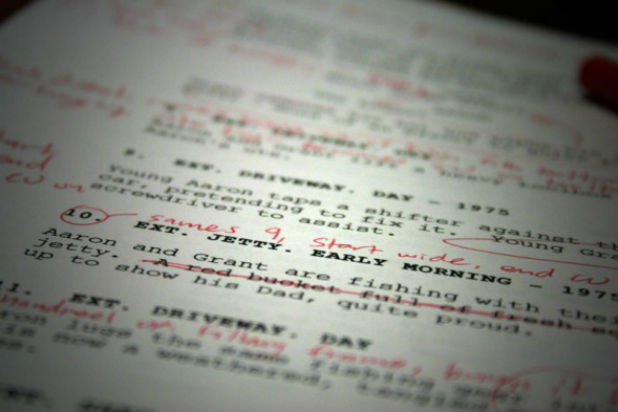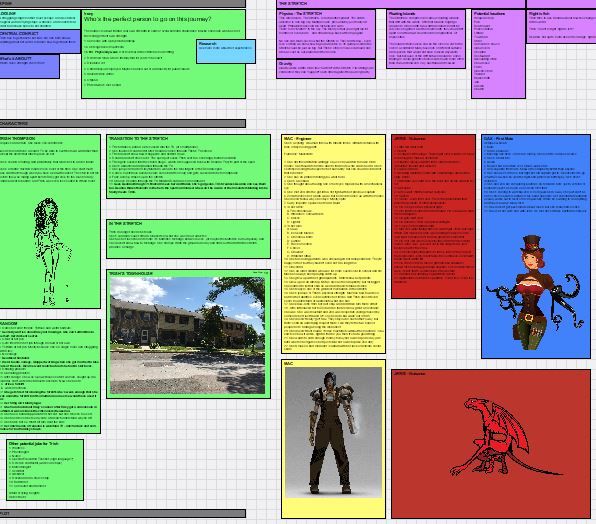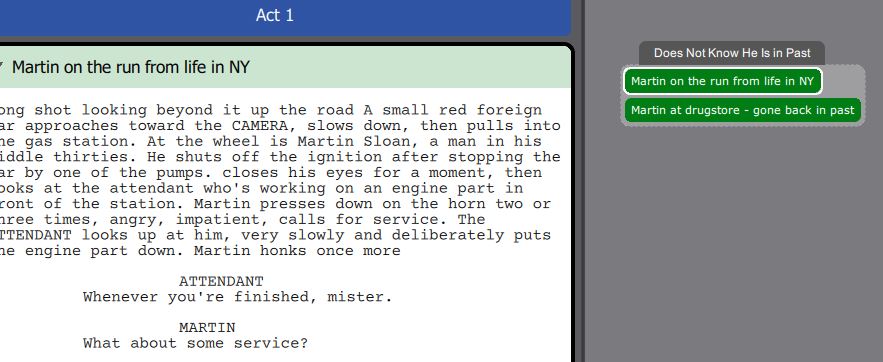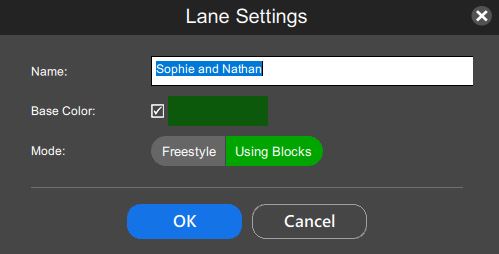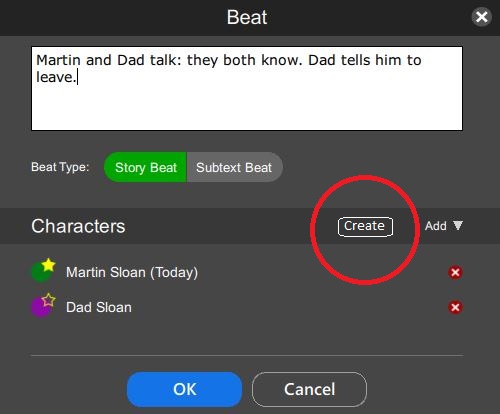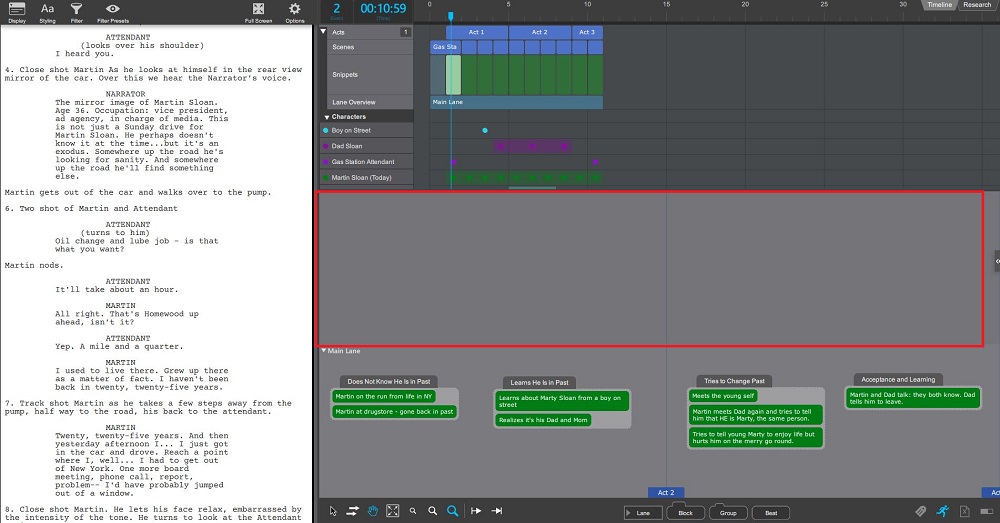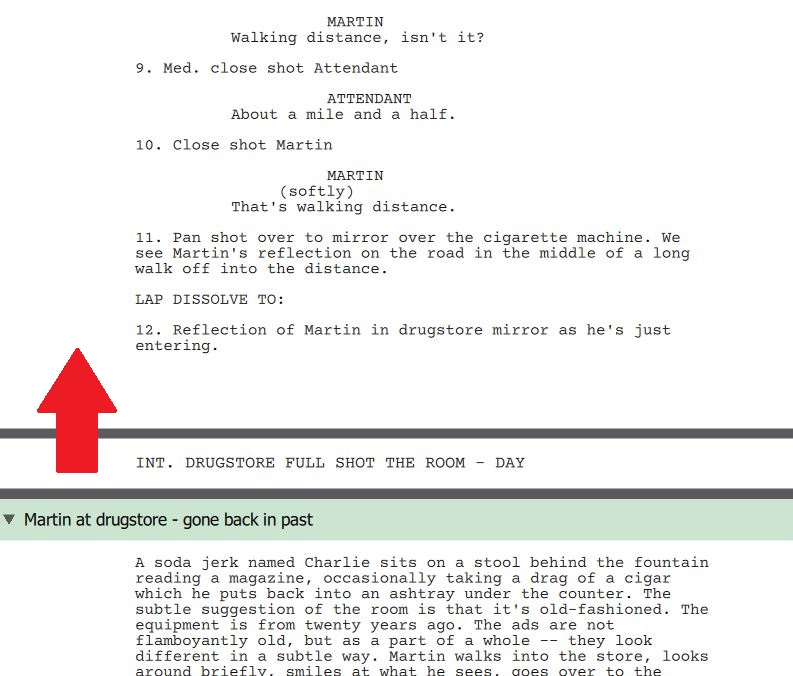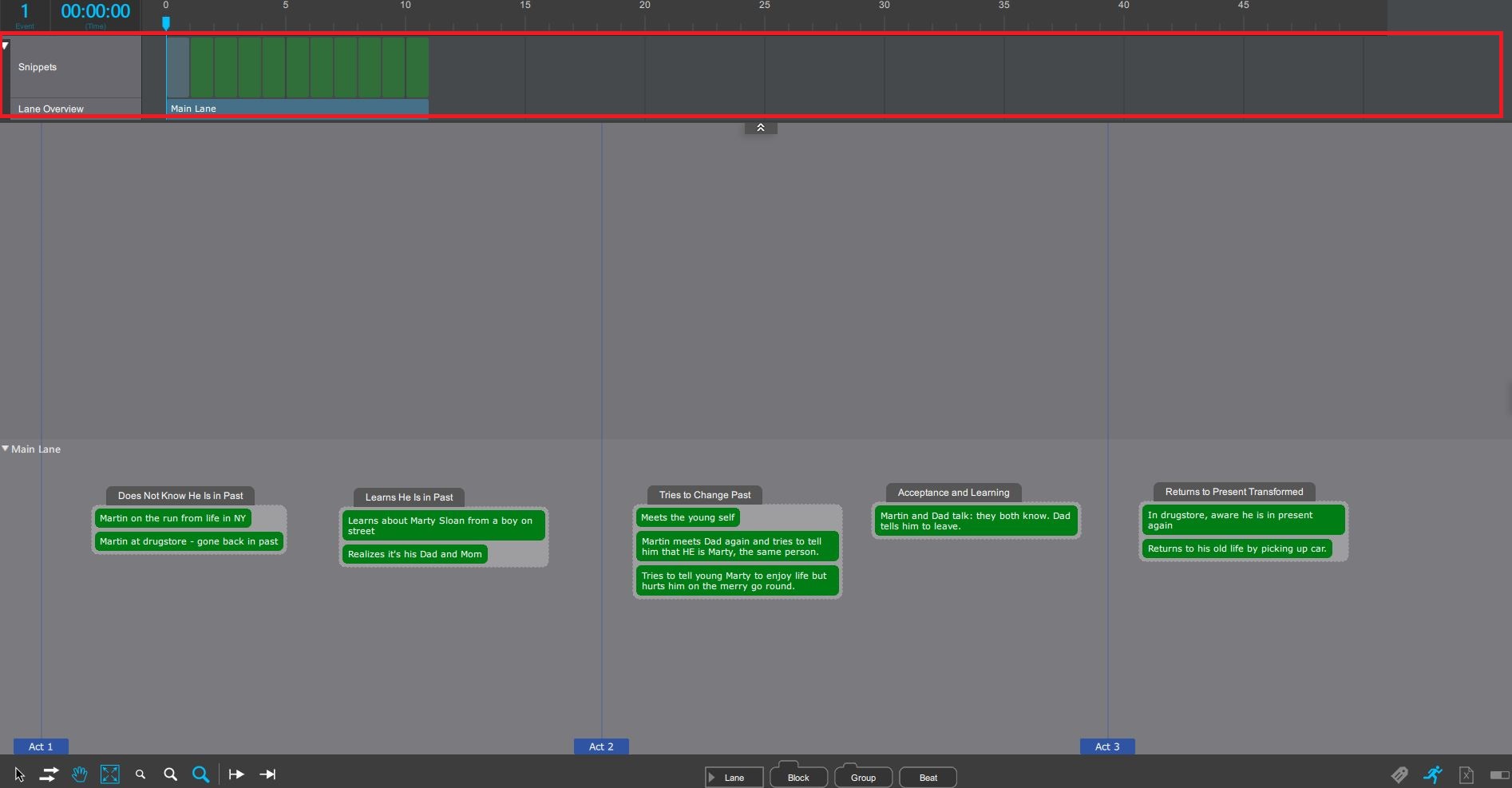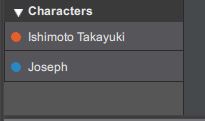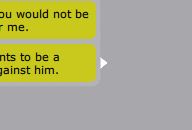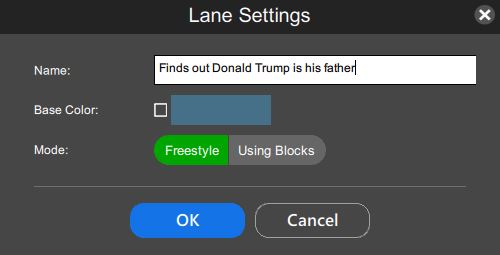For fiction or scriptwriters, it’s the age-old problem of balancing the creative right-brain side of masterful prose, characters, inner thoughts, and scene descriptions–what I collectively will call “writing”–with the structured left-brain planning side of making and moving around chunks of plot. The balance always seems to be off: you’re always too far in one direction or the other.
Then I found Causality, and I’m kind of in love with it. Designed largely as story sequencing software to help you build plots without losing touch on so-called writing part of the script, Causality helps me hit that perfect balance between writing and plotting.
Final Draft vs. Causality
Let’s first get the obvious out of the way. Final Draft is apparently considered the gold standard for script-writing software. If you are a serious script-writer, no doubt you would need to eventually find your way to Final Draft to make sure that your script is perfectly formatted.
Causality isn’t so much about script formatting. It does produce a formatted screenplay. But not being a screenwriter, I cannot comment on the accuracy of Causality’s Final Script formatting.
In terms of structuring, though, compared to Causality the vaunted Final Draft is rinky-dink clown world. The following eye-melting, brain-searing image that looks like it was created in a 1995 version of Microsoft Paint is what passes for structuring in Final Draft in their example script “Airship.”
It might be possible to adjust Final Draft so that it makes more sense and looks better, but I couldn’t be bothered. Final Draft strikes me as a legacy product still resting on its laurels that needs some serious competition to come along and oust it from its position.
What Does Causality Do?
Causality does so much that it is difficult to describe in one blog post. But three features stand out:
Causality Simultaneously Plots and Writes
No, Causality doesn’t actually plot and write for you, but it sure feels that way.
As you create those fat, featureless chunks of the plot on the right side, the left side follows along. So, the Beat called “Martin on run from life in NY,” from the Rod Serling masterpiece script “Walking Distance,” automatically writes the “Martin on run from life in NY” on the left side.
The important point is that plotting and writing activities both exist in the same view and that it is quick and easy to bounce back and forth between the two. Not only that, they have some meshing capabilities.
Causality Lets You Set Up Connections
The image above shows a feature called Connection which lets you link beats when they somehow relate. If an earlier Beat describes, for example, a Mom buying a faulty hairdryer that might result in electric shocks, the other (linked) Beat shows the child playing with the hairdryer and being fatally shocked. Connection allows you to highlight lower-level cause-and-effect relationships, among other things.
Causality Turns Multiple Layers of a Story Into a One Linear Story
How does a multi-layered story work? Imagine playing chess on a three-level, semi-transparent chessboard. When you look at each layer individually, each layer has its own separate story. But when you look at it from above, all of the layers merge to form one board.
Multi-layered stories work the same way (and nearly all stories are multi-layered; it’s just a matter of how layered they are). Even without using Causality, you can craft a story with multiple layers. For ages, writers have plotted stories with walls pinned with index cards separated by lines, long strips of paper, or comparable systems. Causality isn’t inventing anything new. What it does, though, is it automates the process of layering. Simply by dragging a Beat, Group, or Block left or right, you cause it to weave into the overall story in different ways.
Causality Does Not Force You Into a Certain Type of Storytelling
It’s also worth saying what Causality doesn’t do. Some commenters (Reddit, et al) seem to think that Causality forces the writer into a “mechanical, technical” and “meticulous” mode of story-telling. That is completely wrong. Causality is a tool, and make of it what you will. Criticisms like this are akin to saying that a Ferrari, because it can go 200 MPH, forces you to drive 200 MPH. Really?
At one extreme, if you really wanted, you could write the entire screenplay in Script mode, using no Beats, Blocks, Groups, or anything related to structuring. You wouldn’t do this, but you could.
My Opinion of Causality
Causality is a commercial venture bordering on charity for screenwriters or fiction writers who need a better way to plot. Writers who are experts at plotting can only improve with Causality. Writers who are weak at plotting may achieve a respectable level of plotting skill.
Causality is the first story-building software that is truly unique and game-changing, as it helps writers expertly navigate that narrow pathway between plotting and writing.
Try it, buy it. You’ll spend the first few hours lost, but pull up one of their sample files and begin playing around. You can’t break anything. Check out the YouTube tutorials, as well. The online manual is especially helpful.
Even if you are a dedicated user of another platform, Causality will be a valuable supplement.
While I do have a nice, fat 32-inch monitor that serves my needs for my professional writing work, Causality is the first anything that I’ve encountered that has prompted me to immediately start shopping for a couple of extra monitors to create a Causality triptych on my desk.
Bug, Suggestion, and Improvement Log-File
If you’re a hardcore user of Causality, you’ll find this log-file interesting. If you’re still considering Causality, don’t read this as it may give you the impression that the program is riddled with bugs. Rather, Causality is currently a living, breathing thing, continually being improved.
02/01/2020 Update:
Per Holmes has made frequent changes and updates to Causality since the log-file below was published December 2019.
IMPROVEMENT/BUG: Need a Warning to Protect Against User Error When Changing Lane Settings
I’m not sure what to call this one, since it all hinges on user error. But: do not toggle between Freestyle and Using Blocks in the Lane Settings, or you will lose your Block information. Here’s how it all happened:
My Lane, well-populated with many Blocks was, of course, in Using Blocks mode. I went in the dialog, switched over to Freestyle just for the hell of it. All of the Blocks disappeared, leaving only Beats in that Lane. This was expected.
But when I tried to go back, my Blocks were not recovered. They were gone forever. On one hand, this makes sense: “Dude, you obliterated your Blocks; what did you expect?” On the other hand, we need a warning.
But here’s the weird thing. One random Block (out of the original 15 or so) returned. It was not a fresh, new Block but one remnant of the old Blocks, and it encompassed all of the Beats in that one Lane.
I recovered my information only by clicking Redo several times.
IMPROVEMENT: Causality Needs a Cloud-Based Version
Causality is downloaded to your machine. Keeping the program local does make it a faster program, and you can use it when you are offline. But I find myself lacking Causality on my laptop when I am not at home (at home is the desktop computer with the software installed on it), and I cannot download multiple versions of Causality on my two computers, at least as far as I know.
IMPROVEMENT: Users Should Be Able to Create a Character at the Beat Level
Currently, when you start a Beat, you can only Add a pre-existing character. Causality should have a feature that lets you create a character on the fly; this is often how our brains work–by impulse. Instead, it’s a circuitous process. Add a Beat. Close it. Then go up to the Characters list, right-click, Create a Character. Close it. Now, go back to your Beat and Add that character.
IMPROVEMENT: Users Should Have Pre-Set Views
Normally, I scoff at features like pre-set views. I’m usually fine with multiple clicking to move between different views. But Causality often has such a circuitious character that I find it a time-waster to create a view, then switch to another view (say, Final Script), then try to re-create the first view.
In the menu bar there should be space for three pre-set views. This would save much time.
IMPROVEMENT: Users Should Have a Thinner Dead Zone
My own personal bete noir: the dead zone. A dead zone sometimes appears above the Main Lane. It’s not a true Lane, and nothing can be dropped here. It has been described by the company as a type of buffer zone. In the above image, I have dragged down the dead zone as far as possible and highlighted it with a red rectangle. I’m learning to live with it.
IMPROVEMENT: Causality Needs to Graphically Promote Scene Headers in Normal Snippets Mode
In the image above, where does the “INT. DRUGSTORE…” scene heading belong? To the text above or to the text below? Of course, you say, “Below,” because you’re a smart-alecky screenwriter and you know this is the way these things work. Yet if you actually look at this with fresh eyes, you see that visually it attaches itself to the scene above. To my eye, this view is not great at visually identifying taxonomy on script level. Is there a logic behind it? Well, yes. The reason is that the color-banded Snippet is actually an intrusion in the true text: the script. I get it, but it still doesn’t look right and it could be better.
IMPROVEMENT: Users Should Be Able to Change Character Icons
Currently, Characters are represented by a default icon that looks like a time-bomb. Users should ideally be able to change it to a .jpeg icon avatar, so that they can grab a screenshot of an actor, friend, or any real person and use that face. Short of that, users should be able to change the icon to something else.
BUG: Sometimes Headers Cannot Be Created
Sometimes, when you are in the left-hand pane, you click Insert Scene Heading, and nothing happens.
IMPROVEMENT: Users Should Be Able to Set Up Connections by Pressing Object
Connection is one of the coolest features of Causality. But setting up a Connection is a logical hiccup. You set up the first half of the operation one way but complete it another way. So, the first half of the operation is accomplished by clicking on the object, but you set up the second half of the operation with a keyboard operation.
This is not an end-of-the-world problem. But it strikes me as a logical wrinkle. Imagine that you’re in a room and you want to lock the door. You lock the door by sliding the latch shut. To unlock the door, it would make sense to do so with the opposite action: by sliding the latch back. But no. You actually unlock the door by turning on the cold water on the sink.
You’ll get accustomed to this, but it doesn’t follow.
IMPROVEMENT: Causality Needs to Time Out Its Title Page
Reportedly, the company will change this. Currently, the front page sticks and doesn’t leave until you click somewhere on the screen.
IMPROVEMENT: Users Need to Have a One-Click-Only “Move All Left” or “Eliminate Spaces” Option
This would be enormously helpful. Over time, as you work on the Whiteboard and add, delete, and move items, everything sprawls rightward. You only need to hit the Fit All magnifying glass to see how sprawled and gappy everything is. Causality does have a Push feature that lets you slide multiple elements either left or right. But an improved version of that would be a magical “squeeze all” or “move all left” or “eliminate spaces” button, whatever you want to do, that does it all at once.
BUG: Causality Needs to Fix Its Inoperable Upper Area in Full Screen
When you are on Full Screen (thus eliminating the left-hand panel that shows the script), the upper area with Acts, Scenes, Characters, etc. is frozen and inoperable. The area cannot be enlarged or diminished vertically. You cannot scroll that area up or down. However, you can eliminate it by clicking on the double up arrows. Even though this area is frozen, the dead zone below it can be resized.
IMPROVEMENT: Causality Needs to Let Users Rearrange Characters on the Character List
Currently with Causality, if your hero happens to have the name Zachary Zuckerman, he is automatically dropped to the bottom of the character list since it automatically rearranges alphabetically. Users should also have the option to rearrange the characters manually. At the very least, Causality should also have the option of auto-rearranging characters by frequency: characters that show up more frequently at the top, less frequently at the bottom.
IMPROVEMENT: Causality Needs to Do a Better Job of Graphically Distinguishing Between Groups and Blocks
Few things about Causality can I describe as bothersome. Yet I have a hard time with this one. Groups and Blocks: In terms of hierarchy, one is higher than the other, but which? Here is the way it works.
- Block cannot go into a Block
- Block cannot go into a Group
- Group cannot go into a Group
- Group can go into a Block
- Beats can go into Blocks
- Beats can go into Groups
All of that does make sense, but it’s also hard for the user to keep straight. With practice, you do learn. But it seems like it should have a more intuitive aspect.
Not only that, the Blocks and Groups icons look very much alike. The two should graphically be different–markedly so.
BUG: Scrolling Zoom to the Smallest View Freezes Up Your View
When you CTRL + mouse scroll to the smallest possible view, you cannot back out the same way. You need to click on one of the magnifying glasses at the bottom of the program.
IMPROVEMENT: Users Should Have a Way to See All Connections at Once
Once you set up a Connection, it does not remain visible all the time. Understandable. You don’t want to clog up this already-busy screen with even more stuff.
To make a single A-to-B connection visible, you almost have to already know that one is there. Then you locate one end of it via a small triangle. Click the triangle and the dotted connection line shows.
Causality should have an option for clicking one button to see all Connections simultaneously. Preferably, this button should be on the menu bar.
IMPROVEMENT: Users Should Be About to Change Beat Font Size
In this granular world, Beats are the smallest grain. So, font size needs to remain on the smaller size. Yet it would help if Beat font size could be scaled up and down, if even a little.
NITPICKY IMPROVEMENTS
- The dictionary has so few words that it is almost unusable. Yet there seems to be no easy way to populate it with more words on a mass scale.
- No forum? Users should have a forum to trade ideas.
Causality Needs to Let Users Change Lane Settings After Lane-Creation
When you create a Lane, you can set certain aspects like the name and the color of Beats created within it. Yet once the Lane is created, you can no longer change settings.
Update: Found out that double-clicking on the Lane name will bring up the Lane Settings dialog. So, change that to: Causality Needs to Add a Right-Click Option to Change Lane Settings.
Latest Update
2.0.21 (Release)
New Features
- Causations (see https://www.hollywoodcamerawork.com/causality-videos.html)
- French translation by Valery Lambert.
- Italian translation by Chabel Ander.
- Mini timeline in full screen script view.
Improvements
- Page count is now accurate based on background rendering of script.
- Items in whiteboard now align against a hard upper edge.
- Create groups by attaching beats above/below each other.
- Setups/Payoffs are now called Dependencies.
- Dependency lines between beats now hide/show based on line-of-sight.
- Dependency lines now show to/from collapsed lanes.
- Use red color for dependencies that have errors on their endpoints.
- Script now scrolls to location of dropped beat.
- Animations when manipulating whiteboard are now shorter/smoother.
- Disable vertical snapping of visual logic objects.
- Fixed filter checkbox layout.
- Convert to group now stacks beats vertically when possible.
- Change timeline snippet default to 2-lines.
- Lane mode (freestyle/using blocks) is now persisted for future lanes.
- Added a “Delete” context menu option for scene headings.
- Improved inline editing of beats.
- Select document types directly from file menu when creating new doc.
- Allow creating Story Beat or Subtext Beat directly from whiteboard context menu.
Bug Fixes
- Fixed could be difficult to reset selection in certain cases.
- Fixed dropping research items in groups placed them at the end.
- Fixed snippets could assume scene heading of last snippet in script when dropping beat in group.
- Fixed “forbidden” cursor when dropping snippets.
- Fixed bug in upgrader that would refuse to upgrade documents without Characters/Story Tracks.
- Fixed extra space at bottom of freestyle lanes.
- Fixed printing could crash if paragraph text contained separate characters.
- Fixed overview mode for collapsed lanes.
- Fixed bad drop location on collapsed lanes.
- Fixed couldn’t create Lane by dragging in icon from whiteboard toolbar.
- Fixed crash at exit due to undefined behavior.
- Fixed crash on snippet DnD.
- Fixed crash on research object rename.
- Fixed crash caused by using special name for character folder.
- Fixed bad offset when moving concurrent items.
- Fixed defocusing issue in script view.
- Improved fix for undo crash.
- Updated collapsed snippet state handling.
- Fixed wasn’t auto-deleting split beats when deleting their timeslice.
- Fixed clipping issues when moving items into groups.
- Fixed beat type change cancel not working when X-ing the dialog.
- Fixed snippet editor cursor continuing into background areas.
- Fixed Research collapse/expand being swapped.
- Fixed double-click editing option for script breaks in script.
- Fixed accidental snippet creation on new subtext beat.
- Fixed invisible freestyle block title that responded to mouse dragging.
- Fixed that beats dragged from research into whiteboard were placed at end of script.
- Fixed empty group collapse while adding a beat.
